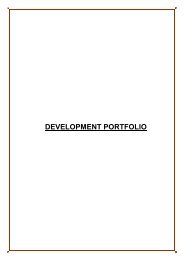Proposed Project for USAID - Wapda
Proposed Project for USAID - Wapda
Proposed Project for USAID - Wapda
Create successful ePaper yourself
Turn your PDF publications into a flip-book with our unique Google optimized e-Paper software.
WATER AND POWER SECTOR DEVELOPMENT<br />
� Irrigated agriculture is the backbone of Pakistan's economy. The agriculture sector is the major user of water<br />
and its consumption will continue to dominate the water requirements. Direct rainfall contributes less than 15<br />
percent of the water supplied to the crops. The major user of water <strong>for</strong> irrigation is the Indus Basin Irrigation<br />
System. About 105 Million Acres Feet (MAF) out of 155 MAF of surface water is being diverted annually <strong>for</strong><br />
irrigation while around 48 MAF is pumped from ground.<br />
� Pakistan has a total of 197 million acres (MA) area out of which 73 MA is cultivable. The cultivated area<br />
(Irrigated & Barani) is 52 MA, whereas 48 MA is irrigated. With large cultivable land base of 73 MA of which<br />
only 27 MA is canal commanded, Pakistan still has the potential of bringing about 20 MA of rain fed land<br />
under irrigation.<br />
� With increased population, Pakistan is fast heading towards a situation of serious water crises. Per capita<br />
surface water availability was 5,260 cubic meters in 1951 when population was 34 million, which has reduced<br />
to 1,038 cubic meter in 2010 when the estimated population is 172 million.<br />
� Due to excessive sediment inflows in the river water, all the three storages (Tarbela, Mangla, Chashma) are<br />
rapidly losing their capacities. By the year 2025, these storages would lose 37% (6.27 MAF) of their capacity<br />
which virtually means loss of one mega storage project.<br />
� An annual average of over 32 MAF water escapes below Kotri varying from 0.3 to 92 MAF. However this<br />
surplus water is available <strong>for</strong> about 70-100 days of summers only. To save and utilize available water,<br />
construction of additional storage facilities is essential <strong>for</strong> sustainable irrigated agriculture which supports<br />
about 70% of the population of Pakistan.<br />
� At present the installed power generation capacity is 20,982 MW. However, the dependable capacity is<br />
19,421 MW out of which 6,516 is being produced through Hydropower, 3,580 by Government (GENCOs),<br />
9637 by Independent Private Power Producers (IPPs) and Private Rental. Gap in demand and supply which<br />
rose to 5,000 MW in summer depicts acute power crises. The demand of power is currently about 20,000<br />
MW which will rise to 36,000 MW in the year 2015. In order to bridge the energy gap the new hydropower<br />
projects are of vital importance.<br />
� At present the hydel/thermal mix is 32:68% whereas it should be the other way round. Though induction of<br />
thermal generation initially helped in overcoming load shedding, it resulted in substantial increase in power<br />
tariff. There<strong>for</strong>e, a sizeable injection of cheaper hydropower through multipurpose storages is the only viable<br />
option to keep the cost of electricity within af<strong>for</strong>dable limits.<br />
� It is an economically unsustainable fact that the total water storages capacity in the country is only 15 MAF<br />
representing 13% of the total annual flows of 136 MAF. To address this problem the Government of Pakistan<br />
(GoP) is developing feasibility and detailed engineering studies <strong>for</strong> nearly 20 MAF of water storage and<br />
25,000 MW of hydel power.<br />
� To facilitate the process of economic development and to ensure greater economic and social stabilization in<br />
Pakistan, it is imperative that employment creation and poverty reduction issues are addressed on priority.<br />
Additional water storages and power generation would <strong>for</strong>m the basis of this strategy during the next decade.<br />
In the next few years: (i) Construction of large dams including Diamer-Basha during 2011 (ii)<br />
Construction of Medium/Small Water Storage Dams (iii) Construction of Canals (iv) Construction of<br />
Transmission Lines <strong>for</strong> dispersal of Power from Hydropower <strong>Project</strong> to Load Centres of National Grid<br />
would be priority issues. These projects would create additional water storages, generate cheap<br />
indigenously developed electricity and prevent flood damages. All these measures would also ensure food<br />
security, employment generation and above all poverty alleviation.<br />
� Due to financial constraints, WAPDA has received only Rs. 9.5 billion out of its allocation of Rs. 27.5 billion<br />
under the PSDP <strong>for</strong> the year 2009-10 which indicates that the ongoing projects would be delayed, resulting in<br />
cost overrun and denying the desired benefits. The financial constraints continued in FY 2010-11 and 2011-<br />
12 when PSDP was reduced from Rs.15.365 Billion to Rs.9.693 Billion and Rs.20.115 Billion out of which<br />
11.977 Billion has been released so far. In view of this financial constraint, WAPDA has made ef<strong>for</strong>ts in<br />
generating financial resources during the current year <strong>for</strong> its projects which are of critical national importance.<br />
<strong>USAID</strong> has signed agreement with WAPDA Repair and Maintenance of Units 1,3 &4 of Tarbela Power House<br />
US$ 16.5 million in year 2010. Besides it also signed Gomal Zam (Power & Irrigation Portion) and Satpara<br />
Dam (Power Portion) on 7.1.2011 & 5.10.2011 <strong>for</strong> providing US$ 80 million and US$ 26 million<br />
respectively. <strong>USAID</strong> has released US$ 50.089 million <strong>for</strong> Gomal Zam Dam, US$ 21.485 Million <strong>for</strong><br />
Satpara Dam <strong>Project</strong> and US$ 10.210 Million <strong>for</strong> Repair & Maintenance of Units 1,3 & 4 of Tarbela Dam<br />
<strong>Project</strong>. The assistance from <strong>USAID</strong> came at the most appropriate time helping WAPDA to complete these<br />
projects. In addition WAPDA has proposed Diamer Basha Dam, Kurram Tangi Dam, Upgradation of Mangla<br />
and Warsak Power Stations and Training and Capacity Building as new projects <strong>for</strong> the assistance from<br />
<strong>USAID</strong>.<br />
4




